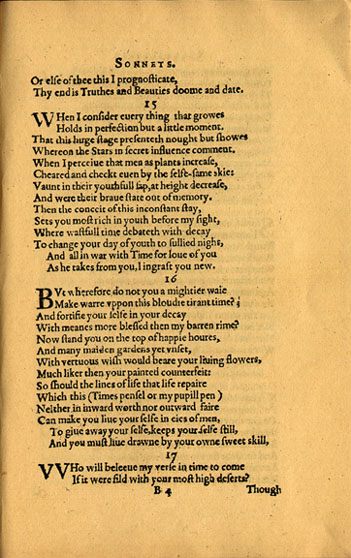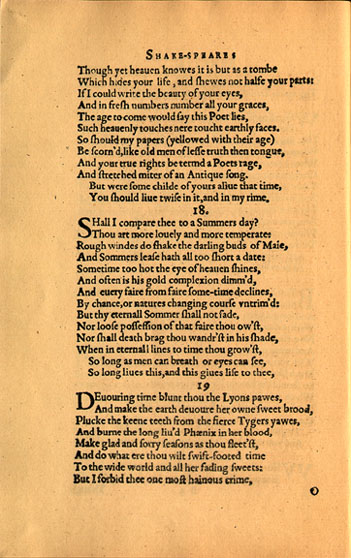Sonnet 17 is one of 154 sonnets written by the English playwright and poet William Shakespeare. It is the final poem of what are referred to by scholars as the procreation sonnets (Sonnets 1-17) with which the Fair Youth sequence opens. Sonnet 17 questions the poet's descriptions of the sequence's young man, believing that future generations will see these descriptions as exaggerations, if the youth does not make a copy of himself by fathering a child. As in Sonnet 130, Shakespeare shows himself to be hesitant about self-assured, flamboyant, and flowery proclamations of beauty.
| Attributes | Values |
|---|
| rdf:type
| |
| rdfs:label
| - سونيت 17 (ar)
- Soneto 17 (es)
- Sonnet 17 (fr)
- Sonnet 17 (it)
- Sonnet 17 (nl)
- Sonet 17 (William Szekspir) (pl)
- Sonnet 17 (en)
- Soneto 17 (pt)
|
| rdfs:comment
| - السونيت 17 هي واحدة من السوناتات الـ 154 التي كتبها الكاتب والشاعر الإنجليزي وليام شكسبير. (ar)
- El Soneto 17 es uno de los 154 sonetos escritos por el dramaturgo y poeta inglés William Shakespeare. Es el poema final de lo que los eruditos llaman los sonetos shakespearianos sobre la procreación (sonetos 1-17) dentro de la secuencia dedica al Fair Youth. (es)
- Le Sonnet 17 est l'un des 154 sonnets écrits par le dramaturge et poète William Shakespeare. (fr)
- Sonnet 17 is one of 154 sonnets written by the English playwright and poet William Shakespeare. It is the final poem of what are referred to by scholars as the procreation sonnets (Sonnets 1-17) with which the Fair Youth sequence opens. Sonnet 17 questions the poet's descriptions of the sequence's young man, believing that future generations will see these descriptions as exaggerations, if the youth does not make a copy of himself by fathering a child. As in Sonnet 130, Shakespeare shows himself to be hesitant about self-assured, flamboyant, and flowery proclamations of beauty. (en)
- Sonnet 17 is de laatste in de serie van zeventien procreation sonnets die het eerste deel vormen van de Sonnetten van Shakespeare uit 1609. In de procreation sonnets, een onvertaalde term die is te lezen als sonnetten voor de voortplanting, doet Shakespeare een oproep aan een jongeman om een gezin te stichten en nageslacht te verwekken, want de dichter kan dan wel zijn kwaliteiten bezingen, maar zijn schoonheid en andere voortreffelijkheden hebben niet het eeuwige leven. Na deze ernstige boodschap verandert de thematiek abrupt in de romantiek van het beroemde Sonnet 18. (nl)
- Sonet 17 (Jak wiersz ten wiarę kiedyś zyska sobie) – jeden z cyklu sonetów autorstwa Williama Shakespeare’a. (pl)
- Sonnet 17 o Who will believe my verse in time to come è il diciassettesimo dei Sonnets di William Shakespeare. (it)
- Soneto 17 é um dos 154 sonetos de William Shakespeare. É o último de seus "sonetos de procriação", aqueles em que ele insiste que o jovem destinatário tenha um filho. (pt)
|
| foaf:depiction
| |
| dcterms:subject
| |
| Wikipage page ID
| |
| Wikipage revision ID
| |
| Link from a Wikipage to another Wikipage
| |
| Link from a Wikipage to an external page
| |
| sameAs
| |
| dbp:wikiPageUsesTemplate
| |
| thumbnail
| |
| has abstract
| - السونيت 17 هي واحدة من السوناتات الـ 154 التي كتبها الكاتب والشاعر الإنجليزي وليام شكسبير. (ar)
- El Soneto 17 es uno de los 154 sonetos escritos por el dramaturgo y poeta inglés William Shakespeare. Es el poema final de lo que los eruditos llaman los sonetos shakespearianos sobre la procreación (sonetos 1-17) dentro de la secuencia dedica al Fair Youth. (es)
- Le Sonnet 17 est l'un des 154 sonnets écrits par le dramaturge et poète William Shakespeare. (fr)
- Sonnet 17 is one of 154 sonnets written by the English playwright and poet William Shakespeare. It is the final poem of what are referred to by scholars as the procreation sonnets (Sonnets 1-17) with which the Fair Youth sequence opens. Sonnet 17 questions the poet's descriptions of the sequence's young man, believing that future generations will see these descriptions as exaggerations, if the youth does not make a copy of himself by fathering a child. As in Sonnet 130, Shakespeare shows himself to be hesitant about self-assured, flamboyant, and flowery proclamations of beauty. (en)
- Sonnet 17 is de laatste in de serie van zeventien procreation sonnets die het eerste deel vormen van de Sonnetten van Shakespeare uit 1609. In de procreation sonnets, een onvertaalde term die is te lezen als sonnetten voor de voortplanting, doet Shakespeare een oproep aan een jongeman om een gezin te stichten en nageslacht te verwekken, want de dichter kan dan wel zijn kwaliteiten bezingen, maar zijn schoonheid en andere voortreffelijkheden hebben niet het eeuwige leven. Na deze ernstige boodschap verandert de thematiek abrupt in de romantiek van het beroemde Sonnet 18. (nl)
- Sonet 17 (Jak wiersz ten wiarę kiedyś zyska sobie) – jeden z cyklu sonetów autorstwa Williama Shakespeare’a. (pl)
- Sonnet 17 o Who will believe my verse in time to come è il diciassettesimo dei Sonnets di William Shakespeare. (it)
- Soneto 17 é um dos 154 sonetos de William Shakespeare. É o último de seus "sonetos de procriação", aqueles em que ele insiste que o jovem destinatário tenha um filho. (pt)
|
| gold:hypernym
| |
| prov:wasDerivedFrom
| |
| page length (characters) of wiki page
| |
| foaf:isPrimaryTopicOf
| |
| is Link from a Wikipage to another Wikipage
of | |
| is Wikipage redirect
of | |
| is foaf:primaryTopic
of | |

![http://dbpedia.demo.openlinksw.com/describe/?url=http%3A%2F%2Fdbpedia.org%2Fresource%2FSonnet_17&invfp=IFP_OFF&sas=SAME_AS_OFF]()



![[RDF Data]](/fct/images/sw-rdf-blue.png)



![[RDF Data]](/fct/images/sw-rdf-blue.png)




![[cxml]](/fct/images/cxml_doc.png)
![[csv]](/fct/images/csv_doc.png)
![[text]](/fct/images/ntriples_doc.png)
![[turtle]](/fct/images/n3turtle_doc.png)
![[ld+json]](/fct/images/jsonld_doc.png)
![[rdf+json]](/fct/images/json_doc.png)
![[rdf+xml]](/fct/images/xml_doc.png)
![[atom+xml]](/fct/images/atom_doc.png)
![[html]](/fct/images/html_doc.png)